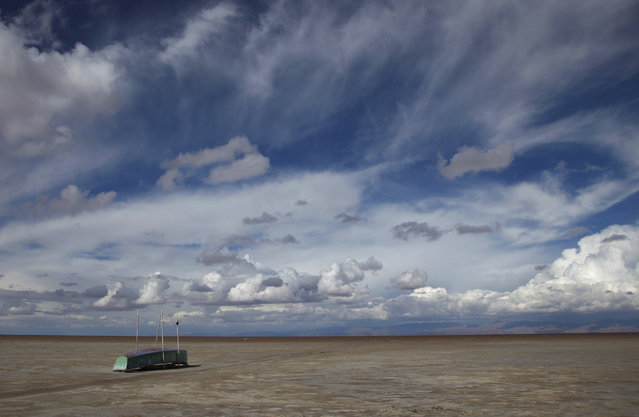
In this January 12, 2016 photo, an abandoned boat lies on the dried up lake bed of Lake Poopo, on the outskirts of Untavi, Bolivia. Drought caused by the recurrent El Nino meteorological phenomenon is considered the main driver of the lake's demise. Along with glacial melting, authorities say another factor is the diversion of water from Poopo's tributaries, mostly for mining but also for agriculture. (Photo by Juan Karita/AP Photo)
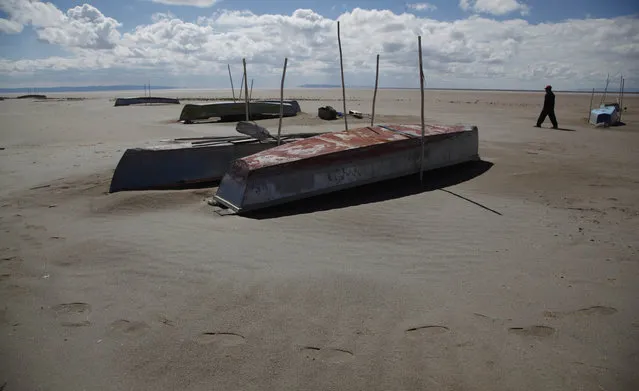
In this January 12, 2016 photo, a fisherman walks along the abandoned boats in the dried up Lake Poopo, on the outskirts of Untavi, Bolivia. As Andean glaciers disappear so do the sources of Poopo's water. But other factors are in play in the demise of Bolivia's second-largest body of water behind Lake Titicaca. (Photo by Juan Karita/AP Photo)
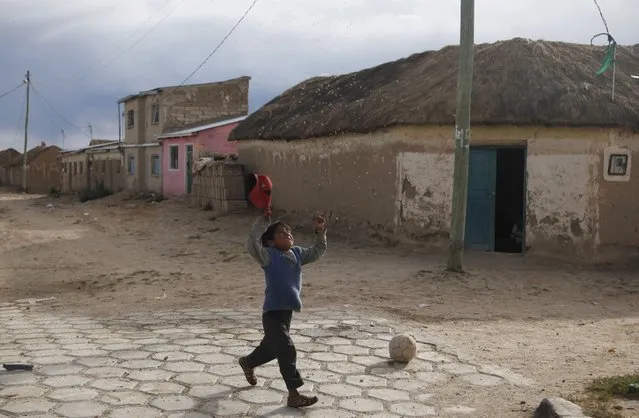
In this January 11, 2016 photo, a boy swats away mosquitoes in Untavi, near the shores of Lake Poopo, Bolivia. Lake Poopo was officially declared evaporated in December 2015. Hundreds, if not thousands, of people have lost their livelihoods and gone. (Photo by Juan Karita/AP Photo)

In this January 11, 2016 photo, a fisherman walks along the abandoned boats in the dried up Lake Poopo, on the outskirts of Untavi, Bolivia. The overturned fishing skiffs lie abandoned on the dried up former shores of what was Bolivia's second-largest lake. (Photo by Juan Karita/AP Photo)

In this January 12, 2016 photo, Abraham Fulguera shows his fisherman's credential, in the dried up Lake Poopo, on the outskirts of Untavi, Bolivia. “I am the president of the September 10 Fishing Cooperative. We used to be 30 fishermen and there used to be ten or more fishing cooperatives in Lake Poopo. Now we work as construction laborers. Others have left to look for jobs. I hope we do not become a ghost town. We have faith that the lake will come back”. (Photo by Juan Karita/AP Photo)
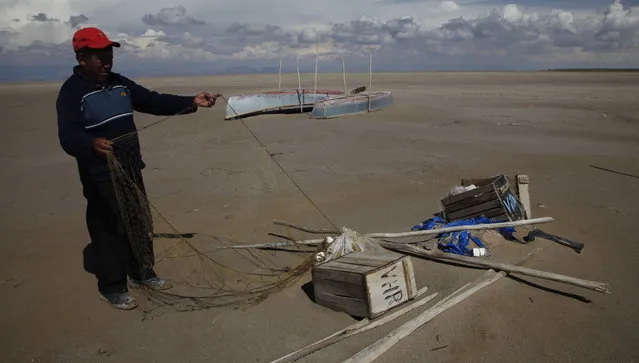
In this January 12, 2016 photo, Abraham Fulguera checks his abandoned fishing net in Lake Poopo, on the outskirts of Untavi, Bolivia. Poopo is now down to 2 percent of what was normal, regional Gov. Victor Hugo Vasquez calculates. Its maximum depth once reached 16 feet. (Photo by Juan Karita/AP Photo)
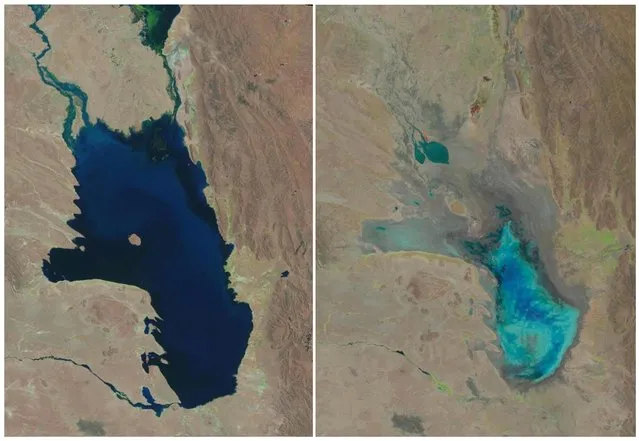
This photo combo of satellite images provided by the USGS shows Lake Poopo filled with water on October 11, 1986, left, and almost dry on January 16, 2016, right, in Bolivia. As Andean glaciers disappear so do the sources of Poopo' water. Along with glacial melting, authorities say another factor is the diversion of water from Poopo's tributaries, mostly for mining but also for agriculture. (Photo by USGS via AP Photo)
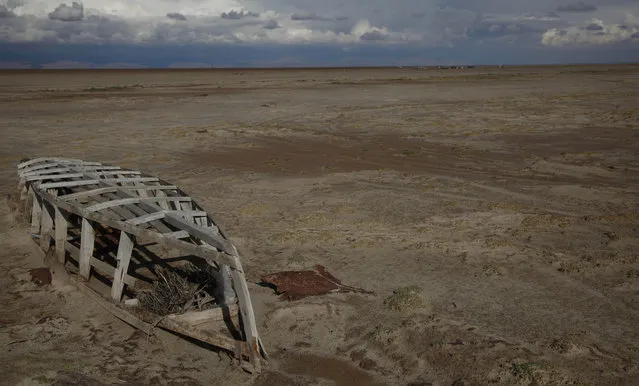
In this January 12, 2016 photo, an abandoned boat lies on the dried up lake bed of Lake Poopo, on the outskirts of Untavi, Bolivia. Environmentalists and local activists say the government mismanaged the lake's fragile water resources and ignored rampant pollution from mining, Bolivia's second export earner after natural gas. (Photo by Juan Karita/AP Photo)
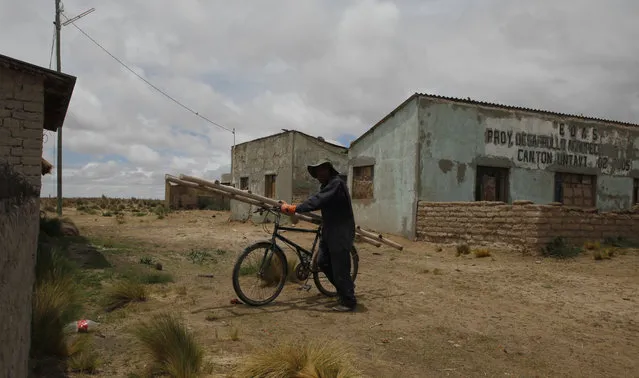
In this January 12, 2016 photo, fisherman Cirilo Choque, carries a ladder on his bicycle, as he walks to his job as bricklayer in Untavi, near the shores of Lake Poopo, Bolivia. “We are really worried because the lake dried up and that the authorities have not helped. Hopefully they will really help us. Before the lake dried up there were about 200 families living here, now only about 70 are left. Most are elderly people or children, the others left to find jobs in the city or other places”. (Photo by Juan Karita/AP Photo)
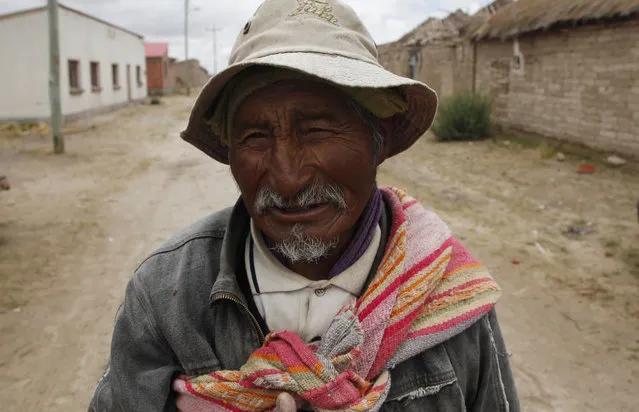
In this January 12, 2016 photo, fisherman Felix Rojas, 78, speak with the Associated Press, in Untavi, near lake Poopo, Bolivia. “With a group of peasants we started fishing in Lake Poopo. With the winnings from fishing I have payed for my children's education and have been able to feed them well. Now we are very sad that the lake has dried up. I do not know what is going to happen to our children and grandchildren? How are they going to survive? But we have to come up with imaginative solutions”. (Photo by Juan Karita/AP Photo)
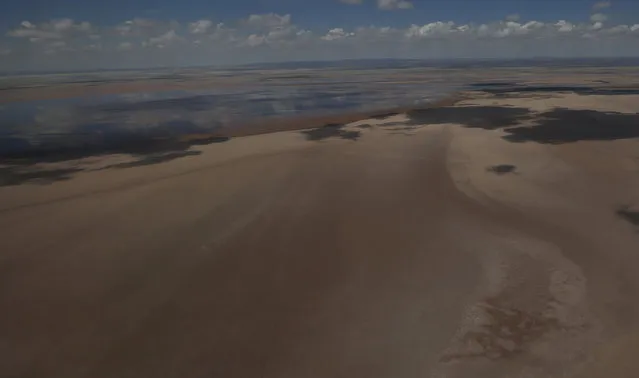
In this January 16, 2016 aerial photo, shows a view of Lake Poopo, Bolivia. High on Bolivia's semi-arid Andean plains at 3,700 meters (2.3 miles) and long subject to climatic whims, the shallow saline lake has dried up before, most recently in the 1940s, only to rebound to an area twice the size of Los Angeles. (Photo by Juan Karita/AP Photo)
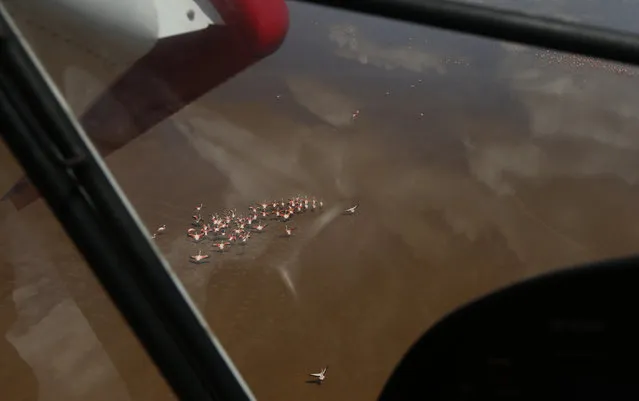
In this January 16, 2016, aerial photo, shows a flock of flamingos on the surface of Lake Poopo, Bolivia. Declared free on any birdlife since it dried up on December 2015, recent rains filled a small part of the lake, bringing back flamingos from the nearby Uru Uru lake. (Photo by Juan Karita/AP Photo)

In this January 16, 2016 photo, a plane flies over the dry lake bed of Lake Poopo, Bolivia. The El Nino weather phonomenon has inflicted periodic droughts on Poopo for millennia and last struck this hard in 1997-98. But over the past three decades unprecedented stress has befallen a fragile ecosystem where 83 percent of rainfall evaporates. (Photo by Juan Karita/AP Photo)
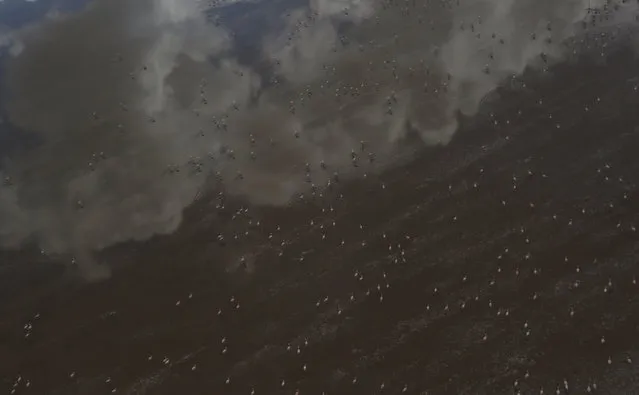
This January 16, 2016, aerial photo, shows a flock of flamingos on the surface of Lake Poopo, Bolivia. Declared free on any birdlife since it dried up on December 2015, recent rains filled a small part of the lake, bringing back flamingos from the nearby Uru Uru lake. (Photo by Juan Karita/AP Photo)
21 Jan 2016 12:33:00,
post received
0 comments
